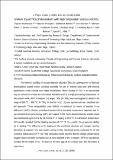| dc.contributor.author | Kumaravel, Vignesh | |
| dc.contributor.author | Rhatigan, Stephen | |
| dc.contributor.author | Mathew, Snehamol | |
| dc.contributor.author | Bartlett, John | |
| dc.contributor.author | Nolan, Michael | |
| dc.contributor.author | Hinder, Steven J. | |
| dc.contributor.author | Sharma, Preetam K. | |
| dc.contributor.author | Singh, Anukriti | |
| dc.contributor.author | Byrne, J. Anthony | |
| dc.contributor.author | Harrison, John | |
| dc.contributor.author | Pillai, Suresh C. | |
| dc.date.accessioned | 2021-03-16T15:57:36Z | |
| dc.date.available | 2021-03-16T15:57:36Z | |
| dc.date.copyright | 2019-08-29 | |
| dc.date.issued | 2019 | |
| dc.identifier.citation | Kumaravel, V., Rhatigan, S., Mathew, S., Bartlett, J., Nolan, M., Hinder, S.J., Sharma, P.K., Singh, A., Byrne, J.A., Harrison, J. and Pillai, S.C. (2019) "Indium-Doped TiO2 Photocatalysts with High-Temperature Anatase Stability", The Journal of Physical Chemistry C, 123 (34), pp.21083-21096. DOI: https://doi.org/10.1021/acs.jpcc.9b06811. | en_US |
| dc.identifier.uri | http://research.thea.ie/handle/20.500.12065/3546 | |
| dc.description.abstract | The thermal stability of anatase titanium dioxide (TiO2) is a prerequisite to fabricate photocatalyst coated indoor building materials for use in antimicrobial and self-cleaning applications under normal room light illumination. Metal doping of TiO2 is an appropriate way to control the anatase to rutile phase transition (ART) at high processing temperature. In this present work, ART of indium (In) doped TiO2 (In-TiO2) was investigated in detail in the range of 500 °C – 900 °C. In-TiO2 (In mol % = 0 to 16) was synthesized via a modified sol-gel approach. These nanoparticles were further characterized by means of powder X-ray diffraction (XRD), Raman, photoluminescence (PL), transient photocurrent response, and X-ray photoelectron spectroscopy (XPS) techniques. XRD results showed that the anatase phase was maintained up to 64 % by 16-mol % of In doping at 800 °C of calcination temperature. XPS results revealed that the binding energies of Ti4+ (Ti 2p1/2 and Ti 2p3/2) were red-shifted by In doping. The influence of In doping on the electronic structure and oxygen vacancy formation of anatase TiO2 was studied using density functional theory corrected for on-site Coulomb interactions (DFT+U). First principles results showed that the charge compensating oxygen vacancies form spontaneously at sites adjacent to the In dopant. DFT+U calculations revealed the formation of In - 5s states in the band gap of the anatase host. The formation of In2O3 at the anatase surface was also examined using a slab model of the anatase (101)
surface modified with a nanocluster of composition In4O6. The formation of a reducing oxygen vacancy also has a moderate energy cost and results in charge localisation at In ions of the supported nanocluster. PL and photocurrent measurements suggested that the charge carrier recombination process in TiO2 was reduced in the presence of In dopant. The photocatalytic activity of 2 % In-TiO2 calcined at 700 °C is more comparable with that of pure anatase. | en_US |
| dc.format | application/pdf | en_US |
| dc.publisher | American Chemical Society | en_US |
| dc.relation.ispartof | Journal of Physical Chemistry C | en_US |
| dc.rights | Attribution-NonCommercial-NoDerivatives 4.0 International | * |
| dc.rights.uri | http://creativecommons.org/licenses/by-nc-nd/4.0/ | * |
| dc.subject | Photocatalysis | en_US |
| dc.subject | Nanomaterials | en_US |
| dc.subject | Titanium dioxide | en_US |
| dc.subject | Doped semiconductors | en_US |
| dc.title | Indium-Doped TiO2 Photocatalysts with High-Temperature Anatase Stability / | en_US |
| dc.type | info:eu-repo/semantics/article | en_US |
| dc.type | info:eu-repo/semantics/preprint | en_US |
| dc.contributor.sponsor | Renewable Engine project - European Union’s INTERREG VA Programme and Department for the Economy and Department of Jobs, Enterprise and Innovation; Science Foundation Ireland; Invest Northern Ireland | en_US |
| dc.description.peerreview | no | en_US |
| dc.identifier.doi | 10.1021/acs.jpcc.9b06811 | en_US |
| dc.identifier.eissn | 1932-7455 | |
| dc.identifier.endpage | 21096 | en_US |
| dc.identifier.issue | 34 | en_US |
| dc.identifier.startpage | 21083 | en_US |
| dc.identifier.url | https://pubs.acs.org/doi/full/10.1021/acs.jpcc.9b06811 | en_US |
| dc.identifier.volume | 123 | en_US |
| dc.rights.accessrights | info:eu-repo/semantics/openAccess | en_US |
| dc.subject.department | Dept of Life Sciences, ITS | en_US |
| dc.type.version | info:eu-repo/semantics/submittedVersion | en_US |
| dc.relation.projectid | (M-ERA.Net 2), Horizon 2020 grant agreement number 685451; SFI Grant Number SFI/16/M-ERA/3418 (RATOCAT); NI (R&D project Novel Dielectrics RD071392). | en_US |


